The Meizu PRO 5 Review
by Matt Humrick on June 24, 2016 8:00 AM EST- Posted in
- Smartphones
- Exynos
- Mobile
- Meizu
- Exynos 7420
System Performance
The Meizu PRO 5’s internal hardware is very similar to the Samsung Galaxy S6’s—Exynos 7420 SoC, LPDDR4 1552MHz RAM, UFS 2.0 NAND—so it’s not unreasonable to expect a similar level of performance. When the PRO 5 and Galaxy S6 launched in 2015, the Exynos 7420 was the SoC to beat, offering better performance and efficiency thanks in part to being the first to use Samsung’s FinFET process. The Exynos 7420 has since been eclipsed by a new generation of SoCs, but it still delivers solid performance.
Smartphones are about more than just performance, of course. Battery life is paramount and is ultimately what makes a mobile device mobile. To help its users strike the right balance between these two opposing metrics, Meizu’s Flyme OS offers three different power modes: Saving, Balance, and Performance. The Saving mode shuts down the four higher-performing but higher-power Cortex-A57 CPU cores, effectively giving the PRO 5 a quad-core Cortex-A53 CPU running at up to 1.5GHz, and is meant to prolong battery life at the expense of performance. The Balance mode, like its name suggests, tries to strike an equal balance between battery life and performance by disabling two A57 cores and capping the max frequency of the remaining two at 1.8GHz. The four A53 cores are still available at their max frequency of 1.5GHz. The Performance mode allows all eight CPU cores to run at their max rated frequencies simultaneously if needed.
To measure the impact of this strategy, we tested the PRO 5 in both its Performance and Balance modes. Results for both are shown in the charts on the next few pages.
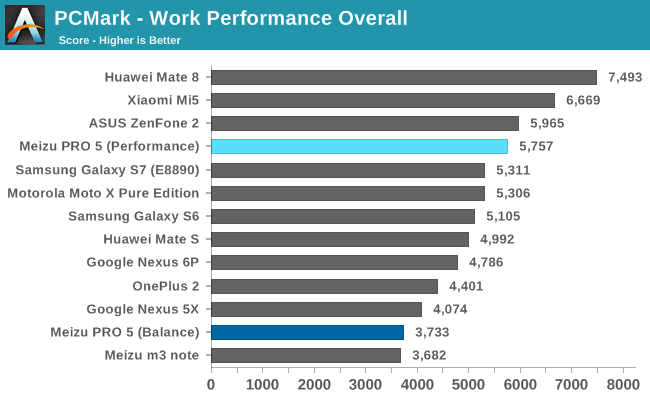
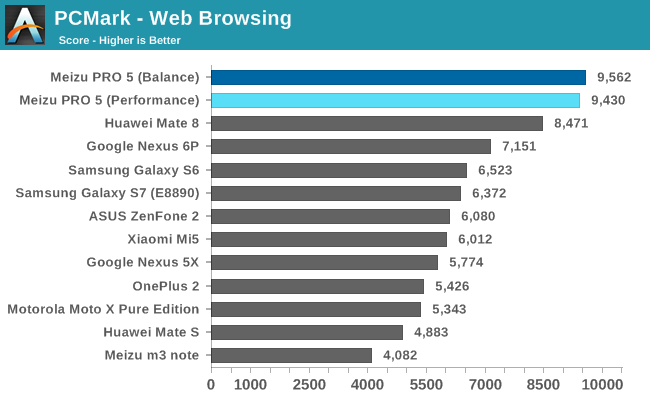
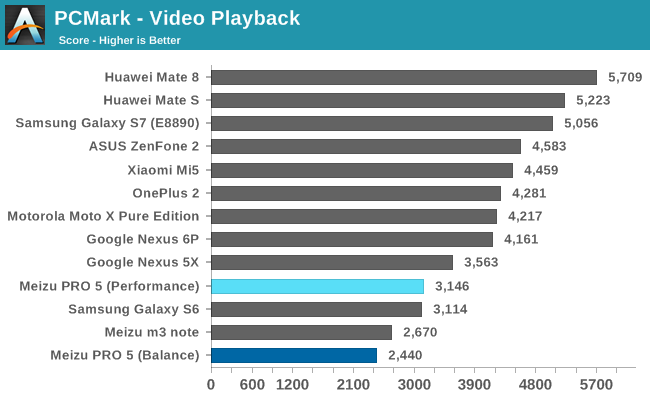
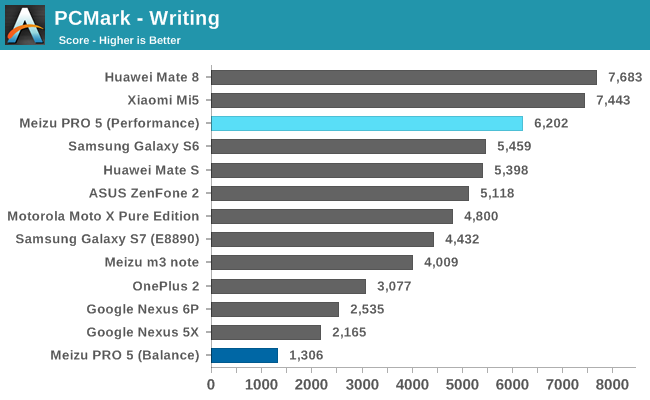
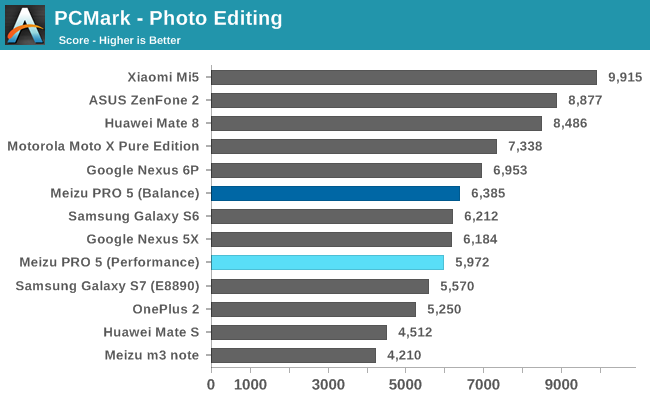
PCMark’s real-world workloads evaluate overall system performance by exercising the CPU, RAM, and NAND storage. Instead of pegging the CPU cores at their max frequency like synthetic benchmarks, PCMark elicits more realistic behavior from the CPU governor, making it a good indicator of how other apps that we use every day will perform.
Looking first at the overall score, the PRO 5 does well, outperforming even newer flagships like the Galaxy S7. We also see a significant difference between the PRO 5’s Performance and Balance modes, with the former providing a 54% boost. However, overall scores can often be misleading.
Diving into the individual tests, the PRO 5 seems to deliver exceptional performance in Web Browsing with no discernable difference between the two power modes. Video Playback is similar to the Galaxy S6 in Performance mode, which holds a 29% advantage over Balance mode, although neither device using the Exynos 7420 does particularly well in this test. The PRO 5, like the S6, performs well in the Writing test, well, at least sometimes.
The PRO 5 produces erratic results in both the Video Playback and Writing tests when using the Performance mode. Around half the time it delivers results similar to those in the charts above. The other times, however, the PRO 5 shuts down the A57 cores completely and idles the A53 cores at 400MHz for the duration of these two tests, resulting in horrible scores. This appears to be a bug with Meizu’s DVFS implementation. The good news is that I was not able to reproduce this scenario while running several different apps from Meizu, Google, and third-parties, so this appears to be limited to PCMark. Without more comprehensive testing there’s no guarantee that some app or workload will not trigger this behavior, however. Using Balance mode could be a workaround, because it did not suffer from this issue.

We recently added DiscoMark to our test suite as part of our effort to better capture real-world performance. You can find a good explanation of how this test works and how we are using it in our LG G5 review, but basically this test measures application launch times by using Android's accessibility services to monitor an application’s startActivity() method, which starts the process of building the app’s UI elements.
The PRO 5 opens apps from internal storage very quickly, noticeably faster than the Nexus 5X and Nexus 6P, and essentially equal to even the latest flagship phones. Switching to Balance mode slows performance by 31%, but it still feels very fast.
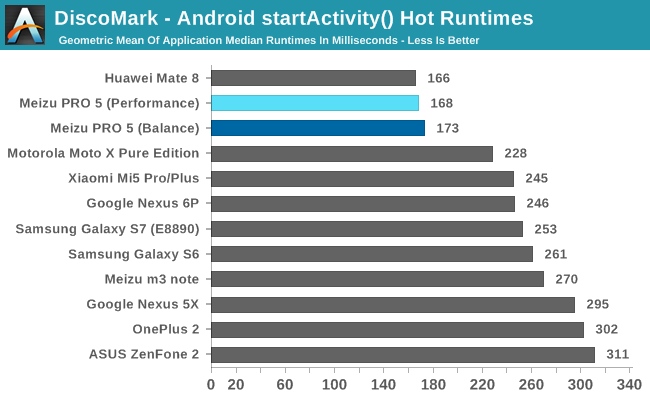
The PRO 5 is also very fast when switching between apps that are already loaded in RAM, with no penalty when using Balance mode. It equals the performance of Huawei’s Mate 8 and P9 and holds a 25% to 35% advantage over the other phones in the chart going back to the Galaxy S6.
Taken together, PCMark and DiscoMark show the PRO 5 performs very well with common, everyday tasks, which agrees with my personal experience while using the phone. The UI is fluid, the keyboard responds as quickly as I can move my thumbs, and scrolling through image-heavy web pages is smooth.

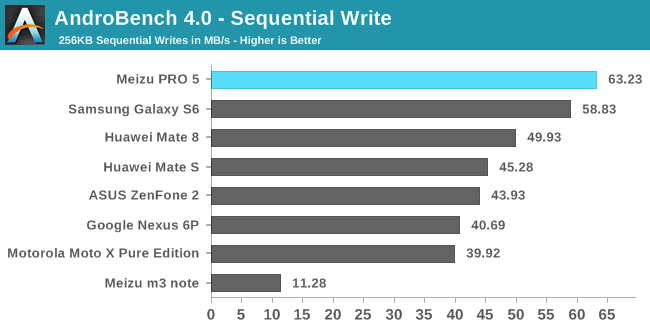
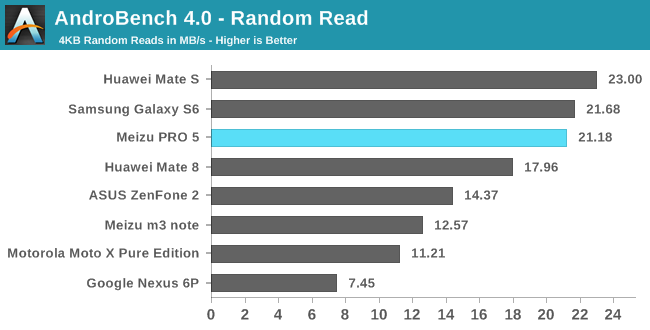
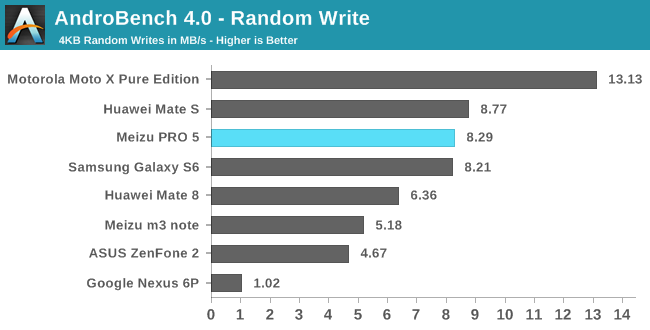
In our internal storage test, the PRO 5 posts very good results across the board, part of the reason why it does so well with launching applications. It’s not surprising that we see the PRO 5 and Galaxy S6 post near identical speeds, because both are using the same UFS 2.0 controller that’s built into the Exynos 7420 SoC and the same KLUBG4G1BD-E0B1 NAND with a maximum queue depth of 16.
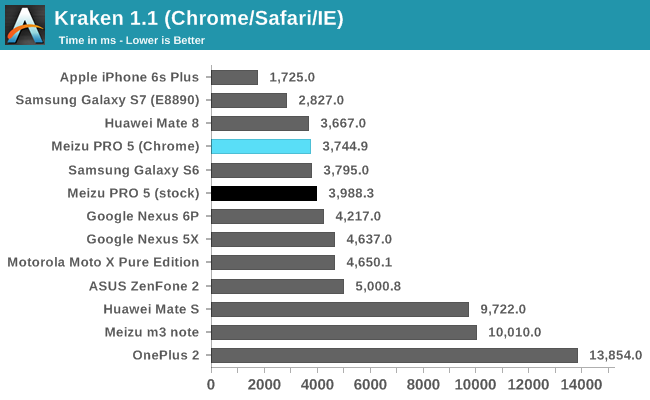
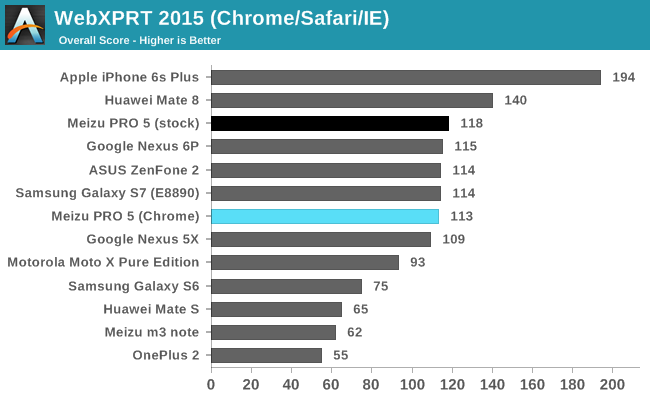

Chrome is the default browser in our web-based JavaScript tests, but we’re also including the results from Meizu’s stock browser for comparison. Unfortunately, it does not provide any better performance than Chrome.
The PRO 5 performs as good or better than the phones with previous generation SoCs. It lands near the top of the chart in Kraken and is around 20% slower than the Mate 8 and its Kirin 950 SoC in JetStream and WebXPRT.
Despite launching at the end of 2015, the PRO 5 still feels plenty fast and compares well to current generation flagship phones. While there is a performance penalty when using the Balance mode to conserve power, it’s generally not severe and not even noticeable in most cases.


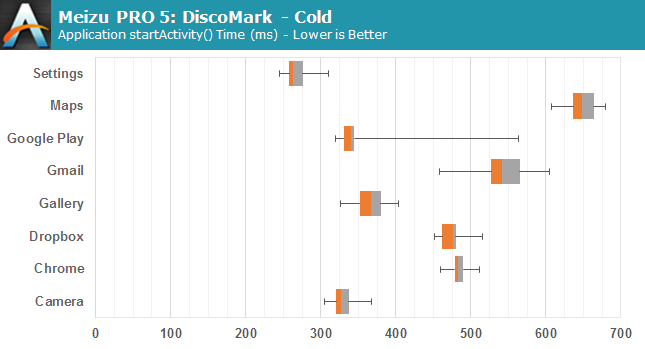









80 Comments
View All Comments
Aaight - Friday, June 24, 2016 - link
So...when is the second half of the s7 review coming out? This is getting ridiculous..Ranger1065 - Friday, June 24, 2016 - link
Anandtech is like a ship with a hole in the bottom, leaking water, and they only seem concerned with getting the ship pointed in the right direction.adriangb - Friday, June 24, 2016 - link
I say keep up the reviews of these Chinese phones! As has been pointed out, just because they're not brought to the US doesn't mean they're not available elsewhere.Also, consider that while AnandTech does put out the most thorough reviews, finding good ones one the newest Galaxy isn't hard. You can also walk into a store and test it yourself. For the rarer phones like Xiaomi, unless you can travel to China and read Chinese, you may not even know what the actual specs (including LTE bands) are before you buy it from some random seller.
justaway2 - Friday, June 24, 2016 - link
http://www.gsmarena.com/xiaomi_mi_5-6948.phpcwolf78 - Friday, June 24, 2016 - link
Why would you review this but not the HTC 10 considering availability? Can you at least do an audio comparison between the two for calls and music on the phone speaker and music performance on headphones? Or have you guys dismissed HTC as a "has-been" and have written them off? I know they aren't Apple or anything, but dayum...I used to come to AnandTech first for reviews, but those are days long gone it seems.
Zoomer - Friday, June 24, 2016 - link
I would like to see a htc ten review as well. It has some interesting features as well, and feel free to skip over the cpu/gpu benches. These are easily available elsewhere. And given the limited review resources, shouldn't devices that aren't near replacement be prioritised?Impulses - Saturday, June 25, 2016 - link
An audio comparison would be very interesting IMO since a lot of other reviewers have highly toured the HTC 10's audio output.kmmatney - Friday, June 24, 2016 - link
How is OS support for these phones? Do they have frequent Android updates? I purchased a Chinese tablet in the recent past, and support was pretty bad. The only real source of support was a forum. Are you going to be stuck on whatever version of Android comes with the phone when you buy it?aryonoco - Friday, June 24, 2016 - link
OS updates are terrible.Security updates are worse.
Once in a blue moon, they might get an update. Generally not an OTA, you have to flash them manually. Even then, count yourself lucky if you get them.
Anyone who cares about security and wanting a phone that gets prompt security updates and is supported for a reasonable amount of time should only look at the iPhone or the Nexus. And buy them outright.
Michael Bay - Wednesday, June 29, 2016 - link
>android anything>security